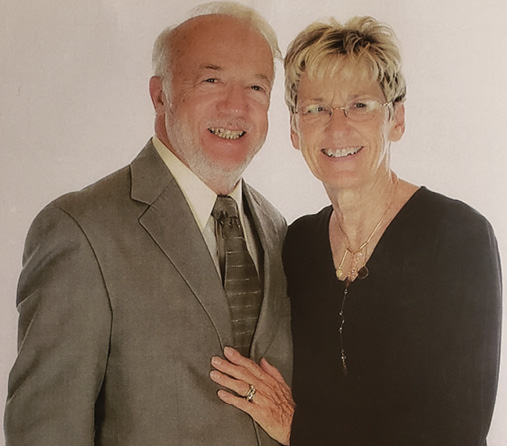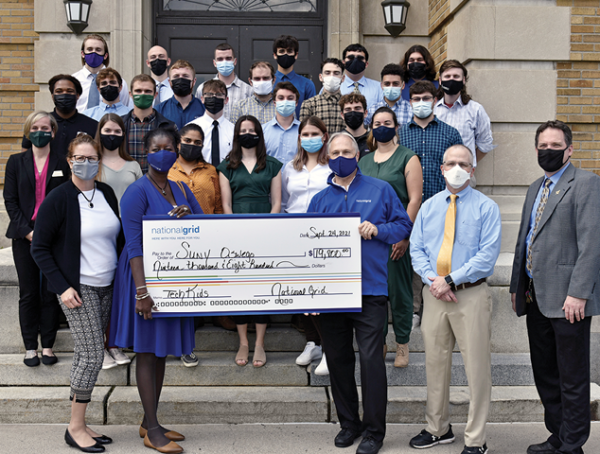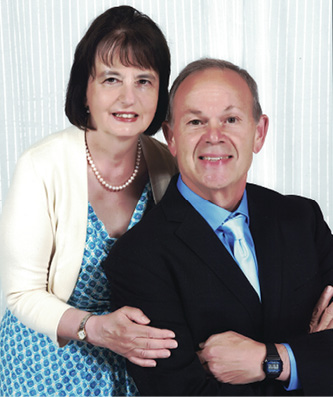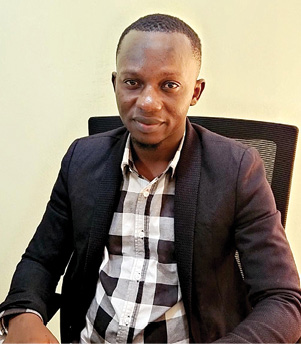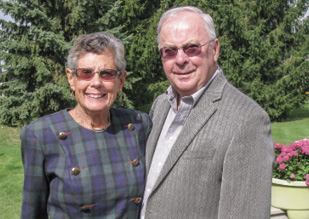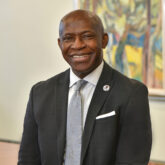Todd Pagano ’96 isn’t trying to win awards.
The Oswego chemistry graduate is focused on doing high-level research in florescence spectroscopy that can help predict the formation of dangerous carcinogens in drinking water and map cancer-causing chemicals in cigarette smoke as a member of the Rochester Institute of Technology faculty.

Pagano’s work involves fluorescence spectroscopy (the “glow” created by certain matter when stimulated by light energy) as it pertains to environmental and medical applications.
He’s devoted to teaching deaf students at the National Technical Institute for the Deaf at RIT, opening for them a new world of scientific inquiry and careers in that promising field.
He’s dedicated to advocating for undergraduate research, acquiring grants to help RIT students conduct research alongside faculty members, as well as publishing and presenting his case for hands-on learning.
He’s not trying to win recognition. Yet the awards just keep coming.
Last fall, Pagano was elected a fellow of the American Chemical Society, an honor reserved for the top one percent of society membership. He was one of only 213 awardees nationwide, recognized for accomplishments in chemistry and service to the ACS.
Last month, he traveled to San Diego to give the keynote address at the national meeting of the American Chemical Society. His former mentor, retired Associate Professor of Chemistry Raymond O’Donnell was at the black-tie affair to see his former student honored with an ACS national award supported by Dreyfus Foundation. That honor came with $15,000 to use in a way that can further the research and teaching he was cited for. It was a proud moment for O’Donnell, who started the student ACS chapter at Oswego.
In February, Pagano won NTID’s top award for research.
In 2005, he received the Richard and Virginia Eisenhart Provost’s Award for Excellence in Teaching from RIT, and in 2008, the Stanley C. Israel Northeast Regional Award for Advancing Diversity in the Chemical Sciences from ACS.
“I’m on a bit of a hot streak,” admits the dedicated scientist, who would rather be sporting a lab coat than a tuxedo.
A Lifelong Goal
Pagano knew he wanted to be in academe ever since his undergraduate years at Oswego. He came to the college from his hometown of Rochester, following in the footsteps of his father, Carmen Pagano ’62. His love of the classroom is something he inherited from his father, a former school principal, and his mother, Eleanor, who was a longtime teacher.
So Pagano accelerated his Oswego degree, graduating in just three years, and enrolled at Tufts University in a doctoral program.
How he landed in front of a classroom of deaf students was a bit of serendipity. When Pagano was finishing up his doctorate someone sent him an advertisement for the teaching position. “I was shocked at how I met all the requirements. It seemed like the position was written for me,” he said — with one important exception. At the bottom of the list it read, “Must learn sign language.”
It was an opportunity to come home — his family was still in Rochester — and to fulfill his dream of a college teaching career. He wouldn’t let a little thing like learning a new language stand in his way.
“I achieved fluency in sign language very rapidly, because I wanted to communicate with my students,” Pagano said. “I wanted to deliver my lessons directly to the students and I didn’t want students asking me questions through an interpreter.”
Now he teaches both hearing and deaf students, inspiring them to careers in chemistry.
Many of his students are from traditionally underrepresented populations.
Nelsey Carcamo was one of the students Pagano inspired. A native of Honduras who is hard of hearing, Carcamo came to NTID with two languages to learn — English and sign language. No one in her family tree had ever attended college. “Professor Pagano immediately made me feel like I had an academic home,” she wrote in supporting him for a teaching award.
Carcamo came to NTID hoping to earn an associate’s degree. Thanks to Pagano’s mentoring, she not only earned a bachelor’s degree, she is enrolled in a
master’s program. She is learning about science, but also about America. As part of her research experience with Pagano, she has traveled to California and Salt Lake City to present their findings.
Roots at Oswego
Pagano learned a lot about how to be an effective teacher at Oswego, he says. Four faculty members especially inspired him.
O’Donnell “opened my eyes to what it meant to be a member of the profession,” he said. O’Donnell took him to his first professional meeting of the ACS. “Every morning I drink my coffee out of the mug I got there,” Pagano said.
Distinguished Teaching Professor Emeritus Kenneth Hyde was Pagano’s advisor and also taught him the introductory chemistry course. “At other institutions, it is a gatekeeper course. Students can be turned on or off — some even become science-phobic,” Pagano said.
“Professor Hyde really cares about his students and teaches it well — he turns them on. In my case, he confirmed for me that I wanted to major in chemistry,” he remembered.
Professor Joseph LeFevre influenced Pagano’s classroom style. He remembered that LeFevre told his students on the first day of class that three things were important to him: God, his family and the students. “He didn’t only say it, he acted in a way that showed he really cared,” said Pagano. “The care he gave his students is something I try to emulate in my class.”
Professor Jeffery Schneider was a new faculty member when Pagano enrolled. “He liked football and I did too,” Pagano said, “He really related to the students. He showed me I could still be who I am — still like football and interact with students in that way.”
Schneider is an environmental chemist and his focus also influenced the choice of Pagano’s research subjects.
Environmental studies
Today Pagano studies how excessive amounts of dissolved organic carbon in drinking water supplies — potentially caused by climate change — when treated with chlorine can produce carcinogenic compounds. In cases of high dissolved organic carbon, water would have to go through costly pretreatment procedures before it can be treated with chlorine. It could be a big problem for Third World countries. Pagano is working on an algorithm to predict the probability of a water supply’s potential to form the dangerous chemicals.
Pagano is also working on a project that is related to lung cancer. Collaborating with bio-engineers who developed a biochemical lung, he studies where different carcinogenic chemicals are deposited in the lungs from the smoking process. He has also recently gotten involved in the study of electronic cigarettes, claimed to be healthier, analyzing them to see if their claims are true and if they are indeed safer. (Since there is no tobacco and no combustion, which together form many of the cancer-causing compounds, these claims may be, in part, true.)
Finally, his pedagogical research on the scholarship of teaching and education — how to make chemistry courses more desirable, how to teach chemistry to deaf and hard-of-hearing populations, and how to conduct undergraduate research — is beginning to gain him recognition. He is the co-editor of the Journal of Science Education for Students with Disabilities and has been invited to present his findings at scientific meetings around the country.
His philosophy of teaching is one of which his Oswego mentors and college founder Edward Austin Sheldon would likely approve.
“The classroom should be student-centered,” Pagano said. “Give them lifelong learning skills — how to be productive learners unto themselves in the future.”
His goal is to break down the science phobia many students have.
“If I go into a middle school, students are so passionate about science. There’s so much enthusiasm, so much magic in the field of science,” he said.
“It’s a tragedy they lose it in high school or early courses in college. We need to keep students aware of the wonder of science.”
That wonder of science, as evidenced in his research and teaching, is the greatest award Pagano could ever receive.
You might also like
More from Alumni Profiles
Astrophysicist, Yale Professor Credits Oswego with Setting His Course for Stellar Career
Astrophysicist, Yale Professor Credits Oswego with Setting His Course for Stellar Career Earl Bellinger ’12 is one stellar guy. A quick review …
BHI Alumnus from Liberia Gains World of Experience
BHI Alumnus from Liberia Gains World of Experience Otis Gbala M’23 became the first SUNY Oswego graduate who studied from Liberia …
Couple’s Loyal Support for Oswego Spans Five Decades
Couple’s Loyal Support for Oswego Spans Five Decades Marilynn “Lynn” Nagy Farrar ’61 and Neil Farrar cherish their memories of Oswego …








